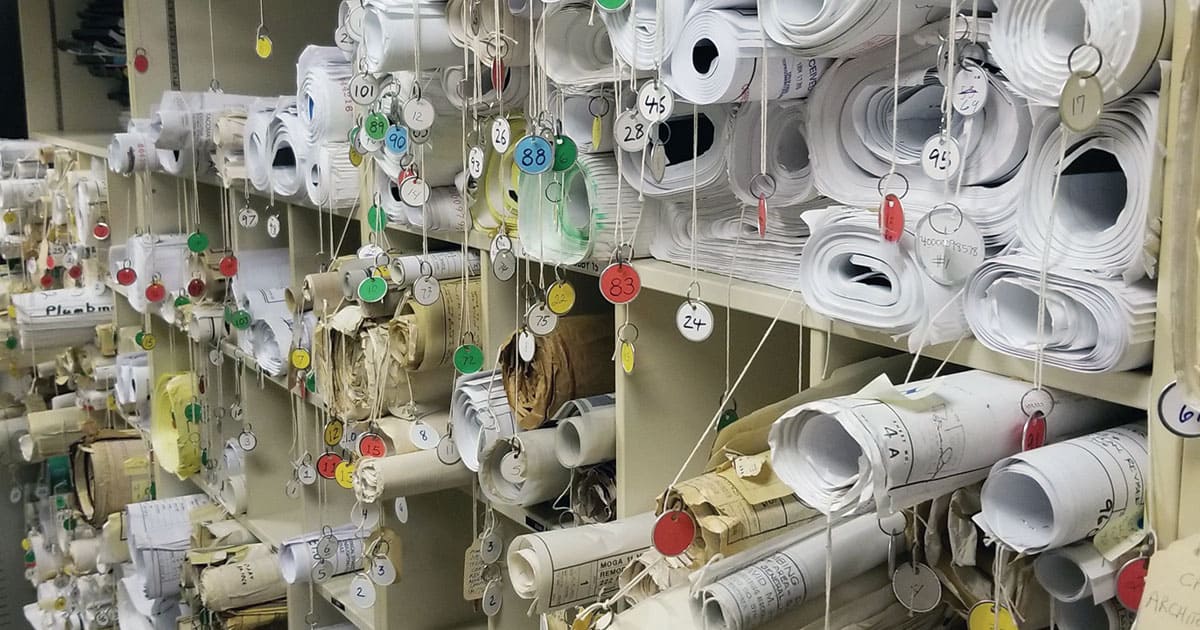By Jack Rubinger
From the June 2021 Issue
Building additions and renovations can double and triple square footage, cost millions, and disrupt building residents. With building renovations, there’s always a sense of discovery about “what’s inside,” such as for mechanicals, electrical systems, and water lines. Enter the facility manager who takes over building responsibilities once construction is completed. When construction is over, facilities are charged with determining how to operate the new space safely and efficiently while managing people, resources, and time.

With every construction or retrofit, there is accumulation of building documentation. Whether you’re the facility manager for a university campus founded in the 1700s or a mid-century community hospital, you are probably painfully aware of the volume of historical and current building documentation in your plan room. Multiple construction projects generate tons of documentation which must be stored, yet accessible for contracting, construction management, design, and facility maintenance teams.
Facilities teams are often dependent on general contractors and subcontractors to provide them with complete and accurate closeout documents at the end of projects. Often, facilities teams must determine how to operate and maintain the newly completed spaces for months without documentation, until the closeout package is complete. This dilemma can be prevented by having a system to track all project documents from the time the construction documents are issued and during every stage of the project. The goal? To incorporate the closeouts into the main facility drawings when the project is completed, and provide a single source of truth for all construction information throughout a renovation project.
Construction closeouts are delivered to facility managers in an array of paper and electronic formats, including three-ring binders, BIM models, and USB drives. Incorporating this additional information into the main body of building information is a constant challenge. The lack of a standard format creates barriers to efficient facilities management when technicians must search through multiple formats of building documentation.
What makes the situation potentially dangerous is not knowing the locations of gas or water shut-off valves for emergencies—especially when you’re on the go.
“Having access to those plans is vital to building operations and future renovations. In a hospital where we are going to knock down a wall next week, it is critical to know ahead of time that there is a water pipe running through the wall now, that wasn’t there when the building was built,” said one facility manager. “Otherwise, if a leak is found, it could cause severe damage, change orders, and construction delays.”
Here are challenges that arise with building documentation during different stages and types of construction projects, and once the building is in operation:
Build. When construction is in process, there are often multiple revisions and change orders, each adding to different sections of the drawing set and specs, and each needing to be organized. All these changes need to be documented and communicated to appropriate team members.
New Buildings. Building operations can’t wait for delivery of the closeout package. Building operations start immediately, and frequently the next renovation project begins before the previous closeout package is received. Given that 90% of project closeouts are still paper-based and contractors often don’t start compiling until the project ends, it often takes six to 12 months from the time a project is completed for a general contractor to deliver the closeout package.
Existing Older Buildings. Current building plans are essential when renovations or building improvements are being planned. Often, only team members with the longest tenure know which drawings are the most current. What if they are on vacation or retired?
Four Steps Stakeholders Can Take:
- Arrange regular meetings between construction and facility management teams. Discuss challenges and opportunities to improve communications.
- Photograph and share renovations/new construction in progress.
- Create agreement contracts for facility and construction teams with a schedule of deliverables and responsibilities.
- Use a mobile-first technology platform in which all key construction documents can be accessed from mobile devices.
When operations and management (O&M) documentation is unavailable or emergency plans are archived rather than on hand, facilities teams can’t do their jobs properly when it’s time to service equipment or address potential emergencies caused by snow storms and freezing pipes. Meanwhile, not having warranty information available could result in paying for service that should be covered— and potentially worse, voiding the warranty by having the wrong company do the service.
Traditionally, building plans and information of all types are stored together causing it to be disorganized. Often drawings get misplaced or misfiled causing more chaos when drawings are required for an emergency or routine maintenance. This is further exacerbated when new documents from expansions or upgrades are added.
What is needed is an intuitive, easy to navigate resource for instantly finding information across the entire enterprise. For facilities leaders, technology has made the job of tracking, updating, and communicating building plans a lot easier, leading to improved project management.
Creating a single source of truth of all construction information isn’t just a pipe dream; it can be a reality. With powerful software accessible on mobile devices, all team members—including contractors, subcontractors, construction managers, and facility managers—can find closeouts and other information instantly.
Rubinger has 20+ years of B2B writing, public relations, and marketing experience. He earned a BA in Journalism from Binghamton University and is a frequent contributor to facility management, construction, healthcare, and industrial safety publications and blogs. Rubinger is currently a content writer at ARC Facilities, developer of a mobile-first technology platform built on five modules for facility managers that provides instant access to building information.
Do you have a comment? Share your thoughts in the Comments section below, or send an e-mail to the Editor at acosgrove@groupc.com.















![[VIDEO] Collect Asset Data at the Speed of Walking a Building](https://facilityexecutive.com/wp-content/uploads/2024/02/maxresdefault-324x160.jpg)